How Long Alpacas Live
When deciding whether alpacas are a good choice for your farm and lifestyle, one important aspect to consider is their expected lifespan. Will alpacas outlive your children’s interest in them? Will alpacas pass away early enough that it could be traumatic for your kids? If your choice doesn’t involve children, then you’re probably focused on the financial ramifications. How long will your alpacas live versus how many years they can produce offspring and/or wool?
So, how long do alpacas live? Alpacas live for an average of 15-20 years, depending on a variety of factors such as their genetics, diet, and the environment in which they are kept. The oldest recorded alpaca lived to be 27 years old.
How long do wild alpacas live? Interestingly, there aren’t any wild alpacas. And not because they’ve gone extinct. Alpacas are the result of decades of domestication of the wild vicunas. While the two are genetically similar, they differ in temperament and behavior. Alpacas were also bred for fiber quality and quantity, so their coats are usually more impressive than those of their wilder relatives, the vicunas.
Factors That Affect Alpaca Lifespan
Just like with humans, lots of different things can affect the health and wellbeing of alpacas, and therefore how long they will be able to live.
Genetics
Jaw Misalignment
Alpacas have continuously growing teeth, just like horses and rabbits. This is necessary for the way their teeth grind back and forth to chew up all the fibrous greens they ingest. Because they continually grow over the course of their lifetime, a small, unnoticeable problem with their alignment can become life-threatening as time passes.
As the teeth wear down over time and continue to grow to make up for it, if one tooth is even slightly out of place and part of it doesn’t get worn down like it should, it could eventually grow so far as to poke through the alpaca’s lip, at the very least causing pain by rubbing against the gums.
Due to problems like this, alpacas may start chewing at a funny angle or adapt in some other way to deal with the problem. And over time, as the teeth get longer, the problems will only intensify and the teeth could slowly push each other out of alignment even more.
Eating could become so difficult and painful that an alpaca begins to starve. The affected tissue in the mouth could become infected, and the infection could spread quickly, especially if the alpaca is weak due to lack of ability to eat.
While this can also be caused by an injury or a sloppy dental job by an inexperienced veterinarian, it is usually genetic. Since this kind of occurrence could not only shorten your alpaca’s life, but also cause significant distress and be expensive, consider investigating the teeth of alpacas from the same family as one you’re considering buying. If looking at the parents is possible, take the time to do so to assure yourself that the dentition genetics are good and not likely to cause difficulties.
And make a point of inspecting your alpacas’ teeth from time to time to make sure no abnormalities are developing. Even if they won’t let you make a close examination without a fight, you can observe them while they chew and watch for any difficulties they may display if a dental problem does develop. The sooner you are able to spot an issue, the more likely you are to be able to fix or at least maintain it in time to save your alpaca’s quality of life so that they can live long and comfortably.
Choanal Atresia
Choanal Atresia is a genetic abnormality that occurs in utero and is the result of the inside of an alpaca’s nose not forming correctly. The result is one or both nasal airways being too small and potentially completely blocked. The face may also be clearly misshapen with this defect.
Because breathing is so difficult with this disease, baby alpacas may be heard gasping while trying to nurse. Due to the extreme difficulty of breathing and nursing struggles, these baby alpacas usually pass away shortly after birth.
Diet Problems That Affect Alpaca Lifespan
Consumption of Moldy Food 
Mycotoxin poisoning happens when alpacas ingest food that has started growing mold. There are some types of mold that are not very dangerous, but even those varieties can cause severe health problems if continually ingested on a regular basis.
Ingestion of mycotoxins can seriously impair the immune system, causing an alpaca to become susceptible to illness and disease that it normally would have been able to fight off without a problem. It can also cause:
- Difficulty breathing
- Reduce appetite
- Weight loss
- Stunted growth (in young animals)
This poisoning can be prevented by ensuring that your alpacas’ food is stored in a cool, dry place. If food is ever exposed to water, it may need to be thrown out. Always inspect food before feeding to ensure it looks as it should.
If you suspect mycotoxin poisoning but are unable to find evidence of mold yourself, have your food stores tested. It may also be a good idea to contact your suppliers and confirm that they regularly test for mycotoxins before mixing foods. If they don’t take this precaution, it would be in your alpacas’ best interests to seek a new supplier who takes more care with their stock.
The sooner you identify this problem, the more likely your alpacas will be to heal from it without lasting health problems that could affect life expectancy.
Hardware Disease
Hardware disease occurs when alpacas accidentally consume a piece of man-made hardware (such as screws, nails, bits of metal, etc.) and can be life-threatening. The presence of certain metals can cause chronic poisoning to the alpaca, not to mention the immediate physical damage that attempting to digest a sharp piece of metal could do to the digestive system. Intestinal lacerations can be fatal and should be avoided at all costs.
Sometimes these objects can be passed naturally. And sometimes they can be removed surgically. But the best possible solution to this problem is to prevent it in the first place.
If you’re doing some construction, be sure to collect all spare bits and pieces as you go. Take care not to drop any garbage near alpaca living areas. And when in doubt, consider purchasing or borrowing a roller magnate and wheeling it over the alpacas’ living quarters to remove any bits of loose metal that might be hanging around.
Acidosis (Consumption of Too Much Grain)
Alpacas need very little grain in their diet. In fact, they can even become sick from consuming too great an amount of grain. Eating grain causes the production of lactic acid, and when too much builds up too quickly, it can be dangerous because it slows down gut movement. This will cause dehydration and can be fatal if not addressed immediately.
Because alpacas are camelids, they won’t show signs of illness as early on as ruminants. For this reason, a vet should be contacted right away as soon as you notice that your alpaca is acting strangely. Symptoms of acidosis include:
- Lying down during a normally active time
- Depressed appearance
- Increased thirst and drinking
- Bloating (specifically on the left side)
- Staggering or “sawhorse” gait
If you see these signs, contact a vet immediately to get professional advice. Your alpaca’s life could depend on it.
Husbandry Problems
Internal Parasites
Alpacas need to be dewormed regularly to prevent life-shortening problems due to internal parasites.
Other Health Problems That Can Impact Alpaca Lifespan
Berserk Male Syndrome 
Sometimes, alpacas are born a bit too weak to suckle on their mothers, or the mothers reject them for some reason. When that happens, usually a human will step in to feed the baby alpaca and help survive. A problem occurs when the alpaca is not properly reintroduced into the herd.
When a baby male alpaca is raised with humans, it doesn’t receive the kind of manners education that only fellow alpacas in a herd can teach. And as a result, when the alpaca reaches sexual maturity, it doesn’t know how to handle all the hormones.
Berserk Male Syndrome rears its ugly head at this point when the male in question begins ramming into everything chest-first at bone-crunching speeds. Humans in particular. Sometimes castration will fix the problem, but no amount of training will ever get the berserk male back under control. Because this situation becomes so dangerous, usually the male must be euthanized to prevent injury or loss of life to herd members and humans.
Properly introducing a baby alpaca back to its mother as soon as it is strong enough to nurse is ideal. If the mother rejects it, then effort must be taken to return the alpaca to the herd to grow up with its own kind as soon as possible.
Heatstroke
Alpacas are from Peru and the surrounding areas, where it does get warm, but typically not above the 90F’s. In the Andes mountains, alpacas’ long fiber comes in handy where the wind is strong and the temperatures can drop quite a bit. They are not naturally built for high humidity.
If you live in a climate that regularly rises into the 90F’s or higher, especially in a humid area, you’ll need to provide your alpacas with some options for cooling down. This is especially important when their fiber is long and nearly ready to be shorn.
An alpaca may have heat stroke if it can be found stumbling around drunkenly in warm weather. Lethargy during a usually active time of day is another sign. If not treated immediately, heatstroke can result in failure of the organs, brain dysfunction, and even death.
To prevent this dangerous circumstance, provide your alpacas with a shaded area that also gets plenty of wind flow. Don’t make them choose between stuffy, humid shade or direct sunlight out in the open.
Be sure that they always have access to plenty of water. Provide multiple watering areas to prevent more dominant individuals guarding water against weaker alpacas. And keep water in the shade whenever possible to keep it cool and slow down evaporation. If heat stroke is suspected, call a vet immediately and do what you can to cool down the alpaca while you wait for vet advice or assistance.
Extreme Cold
Alpacas can handle temperatures below freezing, but if their wool is thin and/or there’s a lot of wind, they’ll suffer. Alpacas should always have a shelter available to escape the rain, but extra care must be taken in the winter to keep the shelter insulated from the wind and warm enough to keep the alpacas manageably comfortable. It may be necessary to provide a heating unit to avoid discomfort and mitigate the risk of frostbite.
This also means it should be big enough to hold the whole herd. Multiple shelters are more ideal than just one so that herd members who do not get along may still enjoy the warmth of the shelter.
Alpacas can continue to breed and produce fiber throughout their entire lifespan. As long as they are provided proper nutrition, housing, and vet care when needed, alpacas can thrive and produce fiber and offspring for nearly all of their lives.
Want to learn more about caring for alpacas? Check out my recent article here!
P.S. Save this article to your “Alpaca” board on Pinterest!

